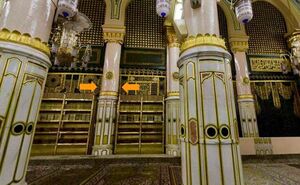Al-Tahajjud Pillar
Al-Tahajjud pillar (Arabic: أُسطُوانة التَهَجُّد) is one of the pillars of Masjid al-Nabi, which was the place of the Prophet's night prayers. When the mosque was empty of worshipers, the Prophet would pray at night next to this pillar; therefore, that pillar is called al-Tahajjud (literally means vigilance). Later, next to this pillar, a mihrab was built, which was named Mihrab al-Tahajjud. It is recommended to pray next to this pillar.
 | |
| General Information | |
|---|---|
| Place | Medina, Al-Masjid al-Nabawi |
| History | |
| Events | The place of the Prophet's night prayer |
| Current State | |
| Status | The pillar was located behind Fatima's house and on its north side. Today it is out of the reach of pilgrims. |
Location
This pillar was originally located behind Fatima's house, on its northern side. A small niche now stands in its place[1], and when one stands facing it, the pillar is on their left, opposite the Bab Jibra'il (Gate of Gabriel).[2] This pillar was situated near the original location of the Gate of Gabriel before the expansion of al-Masjid al-Nabawi, which is now slightly further back of its original place.[3] Currently, it is enclosed within the Prophet's shrine, and a marble slab placed there bears the inscription: "This is the place where the Prophet performed his nightly prayers."
Name
The reason this pillar is called the "al-Tahajjud Pillar" is that, when the mosque was empty of worshippers, the Prophet would spread a mat beside this pillar, which was located behind the door of Ali's house, and would stand there in prayer.[4] Ali (a) also performed his night prayers in this same place.[5]
Due to the imitation of some Muslims, the Prophet removed the mat and, in response to those who asked why, he said: "I fear that night prayer may become obligatory upon you, and you may not be able to do it."[6] Ibn al-Najjar and al-Matari referred to this place as "the nightly prayer place of the Prophet." In later centuries, a niche was built in that location.[7]
Virtues
In the sources, there are narrations about the virtue of praying beside this pillar; for example, Muhammad b. al-Hanafiyya, the son of Imam Ali, said to Sa'id b. Abd Allah b. Fudayl, who was praying there, "This is the place where the Messenger of God used to pray his night prayers; therefore, stay here constantly."[8]
Notes
- ↑ Shurrāb, Al- maʿālim al-athīra, p. 42.
- ↑ Najjār, Al-Durra al-thamīna fī akhbār al-Madina, p. 257; Yamānī, Mawsūʿa Makka al-mukarrama wa l-Madina al-munawwara, vol. 2, p. 420.
- ↑ Qāʾidān, Tārīkh wa āthār-i Islāmi-yi Makka wa Madīna, p.195.
- ↑ Shurrāb, Al- maʿālim al-athīra, p. 43.
- ↑ Najjār, Al-Durra al-thamīna, p. 125; Yamānī, Mawsūʿa makka al-mukarrama, vol. 2, p. 420.
- ↑ Samhūdī, Wafāʾ al-wafā, vol. 2, p. 187.
- ↑ Samhūdī, Wafāʾ al-wafā, vol. 2, p. 189; Shurrāb, Al- maʿālim al-athīra, p. 43.
- ↑ Najjār, Al-Durra al-thamīna, p. 257
References
- Najjār, Muḥammad b. Maḥmūd al- .Al-Durra al-thamīna fī akhbār al-Madīna. Medina: Markaz Buḥūth wa Dirāsāt al-Madīna al-Munawwara, 1427 AH.
- Qāʾidān, Aṣghar. Tārīkh wa āthār-i Islāmi-yi Makka wa Madīna. 4th edition. Qom: Nashr-i Mashʿar, 1381 Sh.
- Samhūdī, ʿAlī b. ʿAbd Allāh. Wafāʾ al-wafā bi-akhbār dār al-Muṣṭafā. Edited by Muḥammad Muḥyi l-Dīn ʿAbd al-Ḥamīd. Beirut: 1984.
- Shurrāb, Muḥammad b. Muḥammad Ḥasan. Al- maʿālim al-athīra fī al-sunna wa l-sīra. Beirut: Dār al-Kutub al-ʿArabī, 1387AH.
- Yamānī, Aḥmad Zakī al-. Mawsūʿa Makka al-mukarrama wa l-Madīna l-munawwara. London: Muʾssisa al-Furqān, 1429 AH.